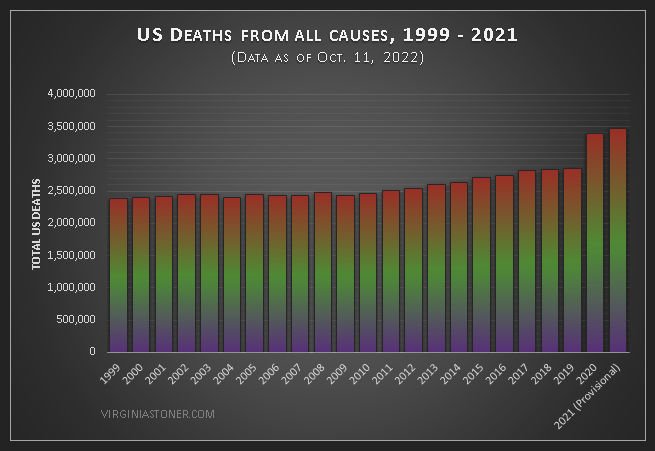A million excess deaths in the US in 2020-2021—none caused by a virus
Chart 1. See Note 1 for the source of this data.
A lot more people died in the US than usual in 2020 (the year of COVID19 diagnoses and ventilators), but even more died in 2021 (the year of COVID19 shots and sudden deaths). 2022 numbers seem a little better so far, but they’ll increase a lot before they’re finalized, so it’s hard to say yet how the year will turn out.
In this post, I use mortality data from the CDC Wonder database to estimate the number of excess deaths in the US in 2020 and 2021—meaning deaths over and above what would ordinarily be expected, based on the historical pattern. This pattern of gradual increase in deaths was remarkably consistent for at least 20 years prior to 2020, as you can see in Chart 1.
Table 1. See Note 1 for the source of this data.
Estimate of excess deaths
Table 1 shows the number of yearly deaths from 1999 through 2021 (illustrated in Chart 1). The 2021 numbers are provisional, and are expected to increase before they’re finalized.
To estimate how many deaths would ordinarily have been expected in 2020 and 2021, if nothing unusual happened, I used the average percentage increase in deaths each year from 2010-2019, which was 1.6%.
Table 2 shows the average increase in deaths each year from 2010-2019, which was about 42,000 deaths, or 1.6% per year. It also shows the minimum and maximum yearly change during that period, which ranged from an increase of about 15,000 to an increase of about 86,000 deaths.
Table 2. See Note 1 for the source of this data.
Table 3 shows the estimated number of excess deaths in 2020 and 2021—just under a half-million in 2020, and just over a half-million in 2021, a combined total of more than a million excess deaths—about 15% of all the deaths that occurred.
Table 3. See Note 1 for the source of this data.
To explain the 2021 Actual numbers in Table 3, Change was based on the difference between the 2020 Expected deaths and the 2021 Actual deaths, a difference of nearly 564,000. The actual increase in 2021 deaths was only 80,501, as you can see in Table 1, which was not an unprecedented number; however, because 2020 deaths were way above normal, 2021 deaths were, too. These numbers were way outside the normal historical range.
Whatever caused a million excess deaths, it wasn’t a virus
Whatever caused the excess deaths, one thing is for certain: it wasn’t a virus, because no such virus exists. I’ve written about this before, and won’t go into it more right now, but the legitimacy of virology is one of the most urgent issues facing humanity, so it’s worth looking into, if you haven’t already.
If you think it’s inconceivable that medical science could be totally wrong for decades about viruses, know that almost exactly the same thing has happened before.
For decades, the medical industry claimed a bacteria called Pfeiffer’s Bacillus caused the flu, and marketed millions of vaccines to the public, military and government to fight this bacteria during the Spanish flu. The medical industry eventually admitted it was wrong in the 1930s, claiming viruses caused flu instead—a questionable claim that is long overdue for an objective and thorough re-evaluation.
Most people don’t know about that historical long-running medical disaster, although there is no legitimate dispute about it—it’s well-documented in a 2010 paper published in the journal of the Office of the U.S. Surgeon General and the U.S. Public Health Service (2).
The reason most people don’t know about it is because the pharmaceutical industry and their buddies in government, media and academia brazenly lie, claiming Spanish flu vaccines didn’t exist, and conceal the fact that the vaccine industry was driven for decades by a false belief that bacteria caused the flu.
The faulty vaccine paradigm and the faulty virus paradigm go hand in hand—if one collapses, so does the other. They are both in danger of collapse right now, and it’s about time.
***
Notes:
1) Results from the CDC Wonder database:
2) Eyler J. M. (2010). The state of science, microbiology, and vaccines circa 1918. Public health reports (Washington, D.C. : 1974), 125 Suppl 3(Suppl 3), 27–36. https://doi.org/10.1177/00333549101250S306 https://journals.sagepub.com/doi/pdf/10.1177/00333549101250S306








